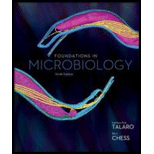
1. a. Is there a microbe that could grow on a medium that contains only the following compounds dissolved in water: CaC03, MgN03, FeCl2,ZnS04, and glucose? Defend your answer.
b. A useful mnemonic device for keeping track of major elements required by most organisms is: C HOPKINS Ca Fe, Na Cl M good. Read aloud, it becomes “See Hopkin’s Cafe, NaCl (salt) M good!� What does each letter stand for?
To determine:
- If any microbe can grow in a medium containing only CaCO3, MgNO3, FeCl2, ZnSO4 and glucose dissolved in water.
- The representation of each letter in C HOPKINS Ca Fe, Na Cl Mgood.
Introduction:
There are some basic components (elements) that are required for microbes to grow. This can easily be determined by the phrase in C HOPKINS Ca Fe, Na Cl Mgood.
Explanation of Solution
- Since there is no source of phosphorous in the given solution this combination may not be helpful for any microbe to grow. Phosphorus is needed for synthesis of the nucleic acids, that is the genetic material of any organism.
- C HOPKINS Ca Fe, Na Cl Mgood is a mnemonic phrase that helps in determining the minimum required elements for life to grow. These are a list of essential nutrients. In this phrase there is a specific representation for each alphabet, which are as follows:
C: carbon
H: hydrogen
O: oxygen
P: phosphorus
K: potassium
I: iodine
N: nitrogen
S: sulfur
Ca: calcium
Fe: iron
Na: sodium
Cl: chlorine
Mg: magnesium
Hence, it may be concluded that, there are some specific elements that are required by all organisms to grow and this may be determined by the mnemonic in C HOPKINS Ca Fe, Na Cl Mgood.
Want to see more full solutions like this?
Chapter 7 Solutions
Foundations in Microbiology
- 2. A mannitol-salt agar plate was inoculated with these bacteria and is shown below. A. What type of organisms grow on this medium? B. Based on the reaction below, what can you say about the organism derived from the patient's abscess?arrow_forward1. If you are a thermophilic endospore forming bacterium what would be the appropriate and economically wise method for your preservation? Which culture collection centers will you select and why?arrow_forward1. Define and differentiate the following terms: a. halophilic b. Capnophilic c. Microaerophilicarrow_forward
- 1. The adsorption solution used in SO2 analysis is…a. Tetrachloromercurate(V)b. Tetrachloromercurate(I)c. Tetrachloromercurate(III)d. Tetrachloromercurate(II) 2. Storage of samples under special conditions is carried out with the aim of…a. Samples that do not enter airb. Avoid repeated samplingc. So that it doesn't rotd. Avoid chemical reactionsarrow_forward1. The technique used in bacteria for endospore staining can also be used to observe fungal spores. Select one: True False 2. Which of the following statements is/are TRUE? a. Agar does not provide nutrients to microorganisms. b. Peptone, pork extracts, and yeast extracts provide nutrients to microbes. c. Tap water must be used for preparing culture media. d. A & B are correct. e. B & C are correct Clear my choice 3. Motility of microorganisms is BEST observed with a a. Flagellar stain b. Hanging drop preparation c. Solid medium d. Negative stain e. Streak plate Clear my choicearrow_forward1.What is the purpose of resazurin in thioglycollate medium? 2.Why does thioglycollate medium have only a small amount of agar in it? 3.How is a facultative anaerobe different from a facultative halophile? 4.Explain how a strict aerobe is different from a strict anaerobe. 5.What would happen to the bacteria if you accidentally closed all of the caps all the way? Would any of the cultures have grown? If so, explain which would grow and which wouldn’t.arrow_forward
- "Microorganisms used a biological warfare." a. What is the scientific name of the microorganism/s and its general characteristics?b. Why those microorganisms are used in such process/product?c. How do/does the microorganism/s impact the lives of human?arrow_forward1. An organism that has peroxidase and superoxide dismutase but lacks catalase is most likely anarrow_forward1(a)What is a psychrotroph? (b)From what natural sources would you isolate a thermophile? A psychrophile? (C)How does temperature affect the growth of a microorganism? (D)State the temperature class for Escherichia coli, Bacillus sp, Aeromonas sp, Micrococcus luteus, and suggest their optimum growth temperature. 2 (a)Why is dilution important when determining microbe number? (B)How does a decrease in dye colour intensity affect the microbe ? (C)State the possible sources of error if plate counts and colour intensity of dilutions are incorrect or Precautions taken to prevent this from happening. ( this is not a graded assignment)arrow_forward
- 1.The formation of a solution is an example of a(n): a, Isothermic process b, Heterogenous process c, Spontaneous process d, Homogenous process e, Nonspontaneous process 2,Solution formation is___________ Group of answer choices a, favored, but not guaranteed by endothermic dissolution processes. b, guaranteed by exothermic dissolution processes c, guaranteed by endothermic dissolution processes. d, favored, but not guaranteed by exothermic dissolution processes.arrow_forward11) The sterilization method that is used to sterilize antibiotics: a) uses halogens b) Phenolics c) Irradiation d) Deep freezing method e) Ultrafiltraion 12) An internal bacterial cell division will lead to the formation of: a) Baeocyte b) Mycellia c) Syncitium d) Myofibril e) all the above13) One of the following compounds doesn’t belong to this list of agents: a) Aldehydes b)Sterilizing Gas c) Quaternary Ammonium Compounds d) Chloramphenicol e)Halogens 14) Most of the growth of bacteria through chemical compounds target: a) Proteins b) Ribosomes c) DNA d) RNA e) Cell wall 15) The antibiotic that prevent the addition of the next amino acid to a growing peptide is: a) Vancomycin b) Tetracycline c) Chloramphenicol d) Sulfonamide e) Cephalosporinarrow_forwardCan you give me an example of a specific medium in culture media and fill the information below. General Information Specific a. Name of medium: b. Physical form: c. Category based on formulation: d. Purpose/uses/function: e. List of Ingredients and concentration (per 1000 ml) f. How to prepare?arrow_forward
 Biology 2eBiologyISBN:9781947172517Author:Matthew Douglas, Jung Choi, Mary Ann ClarkPublisher:OpenStax
Biology 2eBiologyISBN:9781947172517Author:Matthew Douglas, Jung Choi, Mary Ann ClarkPublisher:OpenStax

